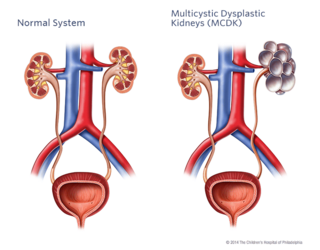What is multicystic dysplastic kidney?
A multicystic dysplastic kidney (MCDK) is the result of abnormal fetal development of the kidney. The kidney consists of irregular cysts of varying sizes that resemble a bunch of grapes.

A multicystic dysplastic kidney has no function and nothing can be done to save it. This condition generally only affects one of the kidneys, the other healthy kidney will usually grow larger to compensate for the cystic one.
Testing and diagnosis
Due to the increased use of prenatal imaging, many children are diagnosed before birth. After birth, a renal and bladder ultrasound is ordered to confirm the diagnosis. On ultrasound the kidney will appear as several cysts with no surrounding functioning kidney. In some situations a renal scan may be ordered to confirm that the kidney has no function.
Treatment
There is no treatment for MCDK. The MCDK will be monitored by the experts in our Division of Urology through a series of ultrasound examinations. Most often, the MCDK will regress and disappear eventually, leaving the child with one healthy kidney.
If the MCDK is not disappearing or is growing larger, surgery may be necessary. The surgery to remove the kidney is called a nephrectomy. At CHOP, this surgery can be done through a minimally invasive approach either robotically or laparoscopy. The advantages are smaller incisions and a faster recovery.
Reviewed by: Division of Urology
Date: May 2011
Resources to help
Division of Urology Resources
Caring for a child with an illness or injury can be overwhelming. We have resources to help you find answers to your questions and feel confident in the care you are providing your child.
